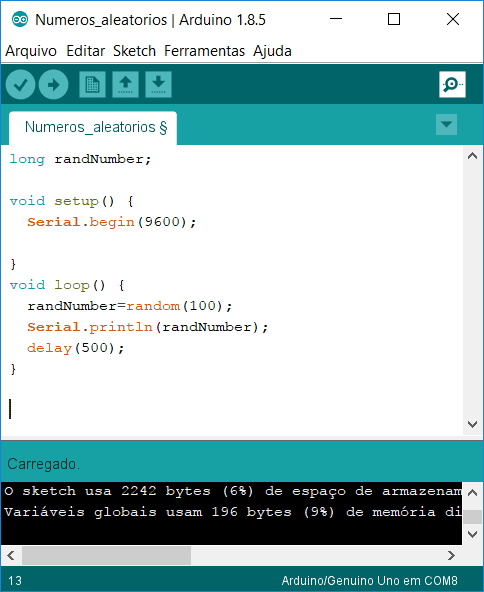

- #GENERATE RANDOM NUMBER ARDUINO SERIAL#
- #GENERATE RANDOM NUMBER ARDUINO REGISTRATION#
- #GENERATE RANDOM NUMBER ARDUINO ZIP#
- #GENERATE RANDOM NUMBER ARDUINO MAC#
It is hard to get a truly random number from Arduino. You're more likely to win top prize in the national lottery 3 times in a row than get two matching UUIDs. UUIDs are globally unique numbers that are often used in web services and production electronics. They are 16 bytes (128 bits) long, which means that generating them randomly This generates a random UUID, and writes it to an array. See the MacAddress example which shows this in use.
#GENERATE RANDOM NUMBER ARDUINO MAC#
Randomly generated MAC addresses are great for projects or workshops involving large numbers of Arduino Ethernet shields, as each shield has a different MAC address, even though they are running identical code. This function writes a 6 byte MAC address to a given address. However, for practical purposes, MAC addresses can be randomly assigned without problems.
#GENERATE RANDOM NUMBER ARDUINO REGISTRATION#
Officially, MAC addresses should be assigned formally via the IEEE Registration Authority. When operating devices on an Ethernet network, each device must have a unique MAC address. (length) bytes are filled in total, starting at the given (address). Like the ANSI C rand() command, this generates a random number between 0 and the highest signed integer 32767.įills a block of bytes with random numbers. Generates a random byte between 0 and 255. This is the core function from which the other TrueRandom libraries are built. randomBit() generates a 0 or a 1 with 50% probability.

Generating true random numbers takes time, so it can be useful to only generate as many random bits as you need. So random(1,7) will generate numbers between 1 and 6. This generates a random number between a and (b-1). So random(6) will generate numbers between 0 and 5.

This generates a random number between 0 and (n-1). Like the Arduino library and ANSI C, this generates a random number between 0 and the highest signed long integer 2,147,483,647. The existing random functions of Arduino are replicated in TrueRandom. The random() function returns the same value every time, but the TrueRandom version is always different. Hit the reset button, and see what it does.
#GENERATE RANDOM NUMBER ARDUINO SERIAL#
Upload that code to an Arduino Duemilanove and watch it on the Serial Monitor at 9600 baud. Then I threw a TrueRandom die and got ") Serial.print("I threw a random die and got ") What happens when you use TrueRandom.random() function? You can move to a different part of the sequence using srandom(), but how do you get a random start point from in the first place? However, Arduino starts at the same point in the sequence every reset. On reset, the formula is reset at a start point, then progresses through a long sequence of random looking numbers. They are actually calculated from a formula. The Arduino default random() function generates what appear to be random numbers. What happens when you use the Arduino random() function?
#GENERATE RANDOM NUMBER ARDUINO ZIP#
Extract the zip file, and copy the directory to your Arduino libraries folder. These restrictions may be removed in future versions of this library.ĭownload TrueRandom library. It does not yet function on the Arduino Mega. TrueRandom currently functions on the Arduino Diecimila, Duemilanove, 168 and 328 based Arduinos. They are different every time you start your program, and are truly unpredictable unlike the default Arduino random() function. TrueRandom generates true random numbers on Arduino.


 0 kommentar(er)
0 kommentar(er)
